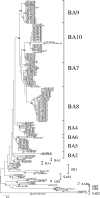New genotypes within respiratory syncytial virus group B genotype BA in Niigata, Japan
- PMID: 20610675
- PMCID: PMC2937669
- DOI: 10.1128/JCM.00646-10
New genotypes within respiratory syncytial virus group B genotype BA in Niigata, Japan
Abstract
Phylogenetic analysis of respiratory syncytial virus (RSV) group B genotype BA strains from the 2002-2003 to 2009-2010 seasons collected in Niigata, Japan, revealed four distinct clusters, designated new BA genotypes BA7, BA8, BA9, and BA10. These new genotypes were not associated with large outbreaks in the community.
Figures


Similar articles
-
Genetic variability of respiratory syncytial viruses (RSV) prevalent in Southwestern China from 2006 to 2009: emergence of subgroup B and A RSV as dominant strains.J Clin Microbiol. 2010 Apr;48(4):1201-7. doi: 10.1128/JCM.02258-09. Epub 2010 Feb 10. J Clin Microbiol. 2010. PMID: 20147636 Free PMC article.
-
Genotypic and phylogenetic analysis of the G gene of respiratory syncytial virus isolates in Okinawa, Japan, 2008.Jpn J Infect Dis. 2009 Jul;62(4):326-7. Jpn J Infect Dis. 2009. PMID: 19628918 No abstract available.
-
Replacement of previously circulating respiratory syncytial virus subtype B strains with the BA genotype in South Africa.J Virol. 2011 Sep;85(17):8789-97. doi: 10.1128/JVI.02623-10. Epub 2011 Jun 29. J Virol. 2011. PMID: 21715483 Free PMC article.
-
Identification of group B respiratory syncytial viruses that lack the 60-nucleotide duplication after six consecutive epidemics of total BA dominance at coastal Kenya.Influenza Other Respir Viruses. 2013 Nov;7(6):1008-12. doi: 10.1111/irv.12131. Epub 2013 Jun 20. Influenza Other Respir Viruses. 2013. PMID: 23782406 Free PMC article.
-
Emerging genotypes of human respiratory syncytial virus subgroup A among patients in Japan.J Clin Microbiol. 2009 Aug;47(8):2475-82. doi: 10.1128/JCM.00115-09. Epub 2009 Jun 24. J Clin Microbiol. 2009. PMID: 19553576 Free PMC article.
Cited by
-
Molecular Evolution of Attachment Glycoprotein (G) and Fusion Protein (F) Genes of Respiratory Syncytial Virus ON1 and BA9 Strains in Xiamen, China.Microbiol Spectr. 2022 Apr 27;10(2):e0208321. doi: 10.1128/spectrum.02083-21. Epub 2022 Mar 21. Microbiol Spectr. 2022. PMID: 35311585 Free PMC article.
-
Genetic Diversity and Molecular Epidemiology of Circulating Respiratory Syncytial Virus in Central Taiwan, 2008-2017.Viruses. 2021 Dec 24;14(1):32. doi: 10.3390/v14010032. Viruses. 2021. PMID: 35062237 Free PMC article.
-
Genetic diversity and molecular evolution of human respiratory syncytial virus A and B.Sci Rep. 2021 Jun 21;11(1):12941. doi: 10.1038/s41598-021-92435-1. Sci Rep. 2021. PMID: 34155268 Free PMC article.
-
Molecular and clinical characterization of human respiratory syncytial virus in South Korea between 2009 and 2014.Epidemiol Infect. 2017 Nov;145(15):3226-3242. doi: 10.1017/S0950268817002230. Epub 2017 Oct 9. Epidemiol Infect. 2017. PMID: 28988544 Free PMC article.
-
A Contemporary View of Respiratory Syncytial Virus (RSV) Biology and Strain-Specific Differences.Pathogens. 2019 May 21;8(2):67. doi: 10.3390/pathogens8020067. Pathogens. 2019. PMID: 31117229 Free PMC article. Review.
References
-
- Agrawal, A., M. Sarkar, S. Ghosh, M. Chawla-Sarkar, N. Chakraborty, M. Basak, and T. Naik. 2009. Prevalence of respiratory syncytial virus group B genotype BA-IV strains among children with acute respiratory tract infection in Kolkata, eastern India. J. Clin. Virol. 45:358-361. - PubMed
-
- Anderson, L., J. Hierholzer, C. Tsou, R. Hendry, B. Fernie, Y. Stone, and K. McIntosh. 1985. Antigenic characterization of respiratory syncytial virus strains with monoclonal antibodies. J. Infect. Dis. 151:626-633. - PubMed
-
- Burland, T. 2000. DNASTAR's Lasergene sequence analysis software. Methods Mol. Biol. 132:71-91. - PubMed
-
- da Silva, L., F. Spilki, A. Riccetto, R. de Almeida, E. Baracat, and C. Arns. 2008. Genetic variability in the G protein gene of human respiratory syncytial virus isolated from the Campinas metropolitan region, Brazil. J. Med. Virol. 80:1653-1660. - PubMed
MeSH terms
Substances
Associated data
- Actions
- Actions
LinkOut - more resources
Full Text Sources
Medical

